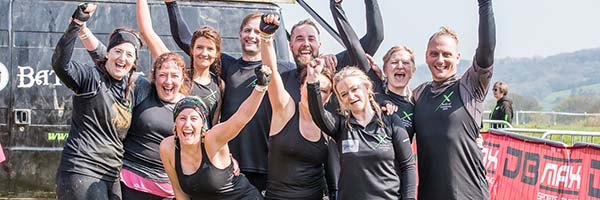Obstacle Course Racing (OCR) is one of the most exciting and rewarding challenges you can take on. From muddy trails and towering walls to crawling under ropes and leaping over obstacles, OCRs push you physically and mentally in ways traditional races can’t. But if you’ve never done an OCR before, it’s easy to feel intimidated or unsure about where to start.
Don’t worry, we’ve got you covered! This guide is packed with tips to help first-timers feel confident, prepared, and ready to tackle the course. Let’s break it down!
1. Train for Strength & Endurance (But Keep It Simple)
One of the most common misconceptions about OCRs is that you need to be a super athlete to participate. That’s just not true! While it’s definitely helpful to build strength and endurance, you don’t need to be able to run a marathon or lift heavy weights to get started.
Here are a few simple training tips:
- Running: OCRs usually involve running on uneven terrain, so get used to trail running or running on varied surfaces. Start with 2–3 runs a week, mixing in some longer runs as you build stamina.
- Bodyweight exercises: Push-ups, squats, burpees, and lunges are excellent for building the strength you’ll need for obstacles. Try doing a simple circuit a few times a week—push-ups, squats, and burpees for 30 minutes will help build the functional strength needed for climbing walls or crawling under nets.
- Grip strength: Many OCRs have challenges that require grip strength (think monkey bars, ropes, and climbing walls). To improve your grip strength, incorporate exercises like farmer’s walks (holding heavy weights), dead hangs (hanging from a pull-up bar), and using a rowing machine.
2. What to Wear (and What Not to Wear)
The right gear can make a huge difference in your comfort and performance. Here’s what you need to know about dressing for your first OCR:
- Footwear: Choose shoes with good grip that can handle mud and wet surfaces. Trail running shoes are ideal, as they provide both traction and comfort. Avoid shoes with too much cushioning, as they can get heavy when soaked. Some OCR-specific shoes even have drainage holes to help water drain out.
- Clothing: Wear tight-fitting clothes to avoid them getting caught on obstacles. Moisture-wicking materials (like polyester or nylon) are perfect for preventing chafing and keeping you cool and dry. Avoid cotton, as it holds onto moisture and can become uncomfortable.
- Gloves: OCR gloves can be useful for protecting your hands on obstacles like monkey bars or ropes. However, make sure they’re designed for OCRs—not thick, padded gloves used for weightlifting. Opt for lightweight, breathable gloves that won’t interfere with your grip.
- Bonus tip: Compression socks can help reduce soreness, and they protect your legs from cuts and scrapes, which is especially useful when crawling through muddy sections or over rough terrain.
3. Focus on Mental Prep
OCRs are as much about mental toughness as they are about physical strength. The obstacles will challenge you, but your mindset will play a huge role in how you tackle them. Here are some ways to mentally prepare:
- Set realistic expectations: This is your first OCR, and it’s about having fun and challenging yourself—not necessarily about finishing in a record time. Don’t worry if you can’t do every obstacle perfectly. Just keep going!
- Embrace the mud and mess: OCRs are messy by nature, and you’ll get dirty. The more you embrace the fun and chaos, the easier it will be to stay in a positive mindset.
- Focus on the team spirit: OCRs are incredibly supportive events, with lots of people helping each other out. Whether you’re racing with friends or making new ones along the way, remember that teamwork is often key to success.
4. Race-Day Tips
When the big day arrives, it’s natural to feel a little nervous—but here’s how to stay calm and enjoy the experience:
- Arrive early: Get there with plenty of time to spare so you can register, check out the course, and get comfortable. This also gives you time to warm up before your race starts.
- Start slow: Don’t go all out at the beginning. Pace yourself—OCRs are about endurance, not sprinting. Conserve your energy for the later obstacles when you’ll really need it.
- Hydrate and fuel: Make sure to hydrate well the night before and drink water during the race, especially if it’s hot. Some OCRs may provide water stations, but it’s always a good idea to bring your own, just in case.
- Embrace the obstacles: When you approach an obstacle, take a moment to breathe and assess. Many people get stuck because they rush or panic. Visualise how you’ll conquer it, and don’t be afraid to ask for help from other participants if you need it.
5. Why OCRs Are About More Than Just the Finish Line
One of the best things about OCRs is that they are truly inclusive. You don’t need to be an expert or an elite athlete to take part. What matters most is your effort, attitude, and willingness to get out of your comfort zone.
OCRs are also amazing for community-building. Whether you’re running solo, with friends, or as part of a team, the sense of camaraderie is palpable. Many people help others on obstacles, cheer on fellow racers, and share the joy of completing the challenge together.
DB Max OCR Events: Your First OCR Awaits
If you’re feeling inspired, the DB Max OCR Events are the perfect place to start. Our races are designed with beginners in mind—challenging yet fun, with plenty of support and a great community spirit.
Whether you’re tackling your first OCR in 2025 or beyond, we’re here to help you every step of the way. Get ready for mud, fun, and unforgettable memories!
Back to Blog



